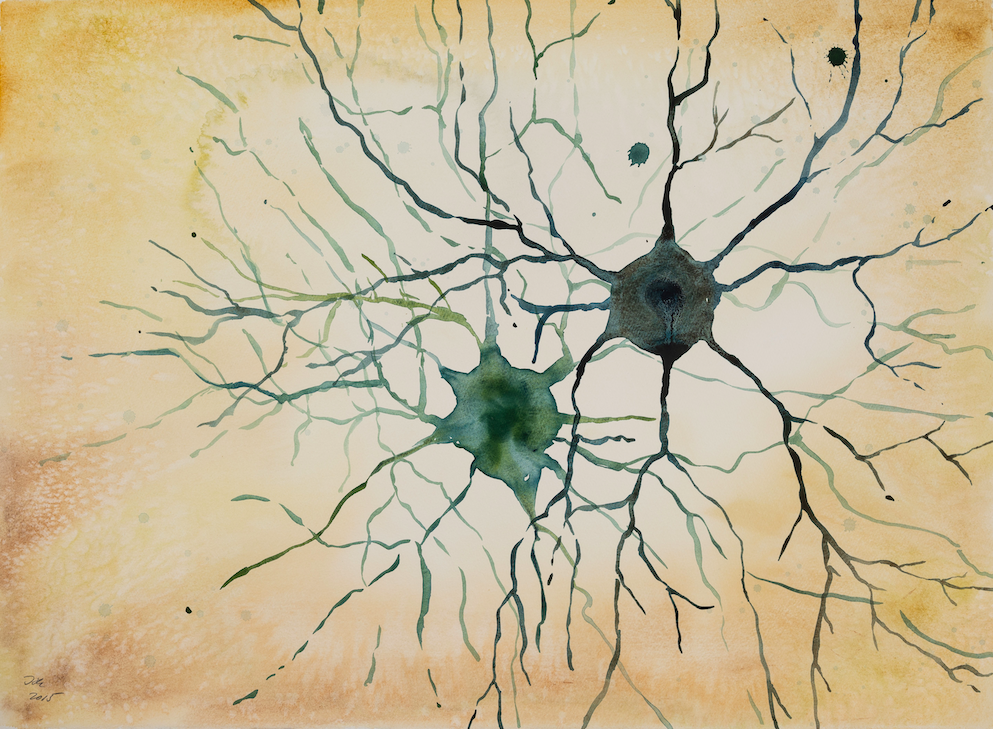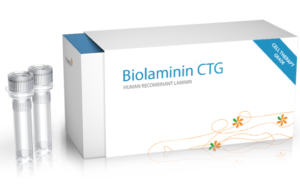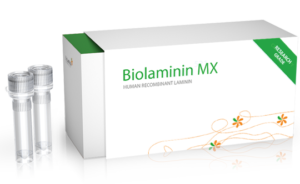Applications – Dopaminergic neurons
Dopaminergic neurons

Biorelevant culture of dopaminergic neurons on Biolaminin substrates
Biolaminin culture supports GMP-compatible differentiation of dopaminergic cells
Parkinson’s disease (PD) is a complex and progressive neurodegenerative disorder that is characterized by the severe loss of midbrain dopaminergic (mDA) neurons, causing progressive loss of motor control and function. Parmar and colleagues showed in Cell Stem Cell (2016) that Biolaminin 111 can be used in the GMP-compatible differentiation of hESCs to dopaminergic cells (Kirkeby, 2016). This protocol results in defined, animal origin-free, and clinically compliant progenitor cells, that express the markers identifying the right type of mesencephalic dopaminergic neurons. Importantly, the yield of the correctly specified progenitors increased 43-fold compared to other embryoid body-based protocols. The protocol has been validated in several independent labs and with many hESC and hiPSC lines. In all cases, the hPSCs are expanded using Biolaminin 521, making the starting hPSC population homogenous and stable before the initiation of DA differentiation experiments.
A detailed protocol for better purity and high yield of dopaminergic progenitors for transplantation
The same group has published a detailed 16 days protocol for obtaining high-purity ventral midbrain (VM) dopamine (DA) progenitors for intracerebral transplantation into animal models and for in vitro maturation into neurons (Nolbrant, 2017). The protocol is free of animal-derived products and can be performed under good manufacturing practice (GMP) conditions. The authors successfully transplanted such cells into the rat and the protocol is designed to be compatible with clinical transplantation into humans. By specifying how to perform quality control, troubleshooting, cryopreservation of the progenitors for shipping, and adaptation of the procedure, this protocol will facilitate implementation in different laboratories and with a variety of hPSC lines. (Nolbrant, 2017).
Niche-specific laminin promotes midbrain dopaminergic neuron survival and differentiation
Zhang et al. (2017) investigated the mechanisms controlling the survival of mDA neurons and identified laminin 511-YAP as a key pathway by which niche signals control the survival and differentiation of mDA neurons. The authors found that YAP was activated in midbrain dopaminergic neurons in culture and in mice through an interaction between integrin a3b1 and the extracellular matrix protein laminin-511. YAP then transcriptionally activated dopaminergic neuron differentiation factors and a microRNA that decreased the synthesis of the apoptotic protein PTEN. The findings uncover a new role for YAP in neurons and a pathway that might be explored for the purpose of promoting dopaminergic neuron survival in PD patients.
Efficient midbrain dopamine differentiation and improved grafting outcomes in parkinsonian rodents
Niclis and coauthors (2016) reported the generation of highly pure midbrain dopamine cultures from hPSCs under feeder-free, fully defined, and animal origin-free conditions. The cells displayed gene, protein, and electrophysiological properties of midbrain neurons, as well as improved grafting outcomes in parkinsonian rodents. Furthermore, ventral midbrain dopamine neurons were amenable to scalability and cryopreservation, crucial steps for the advancement of cell replacement therapy in Parkinson’s disease.
WHAT OUR CUSTOMERS ARE SAYING
“We have struggled for a number of years to establish a GMP manufacturing process for generating DA neurons from human embryonic stem cells in order to develop a stem cell-based therapy for Parkinson’s disease. The recombinant laminins from BioLamina really made a world of difference!”

Prof. Malin Parmar,
Lund University, Sweden
Succeed with your application
-
Direct Reprogramming of Human Fetal- and Stem Cell-Derived Glial Progenitor Cells into Midbrain Dopaminergic Neurons
Nolbrant S., Giacomoni J., Hoban D.B, Bruzelius A., Birtele M., Chandler-Militello D., Pereira M., Rylander Ottosson D., Goldman S.A., Parmar M. Stem Cell Reports, 2020
Read more -
Generation of high-purity human ventral midbrain dopaminergic progenitors for in vitro maturation and intracerebral transplantation
Nolbrant S., Heuer A., Parmar M., Kirkeby A. Nature Protocols, 2017
 Read more
Read more
-
Efficiently Specified Ventral Midbrain Dopamine Neurons from Human Pluripotent Stem Cells Under Xeno-Free Conditions Restore Motor Deficits in Parkinsonian Rodents
Jonathan C Niclis, Carlos W Gantner, Walaa F Alsanie, Stuart J McDougall, Chris R Bye, Andrew G Elefanty, Edouard G Stanley, John M Haynes, Colin W Pouton, Lachlan H Thompson, Clare L Parish. Stem Cells Transl Med, 2017
Read more -
Predictive Markers Guide Differentiation to Improve Graft Outcome in Clinical Translation of hESC-Based Therapy for Parkinson’s Disease
Kirkeby A., Nolbrant S., Tiklova K., Heuer A., Kee N., Cardoso T., Rylander Ottosson D., Lelos M.J., Rifes P., Dunnett S.B., Grealish S., Perlmann T., Parmar M. Cell Stem Cell, 2016
Read more -
Application note 013: Dopaminergic progenitor differentiation on Biolaminin substrates
Improved neural cell yield and safety with biorelevant matrix
Open pdf
Prof. Malin Parmar
Stem cell-based treatment for parkinson’s disease
Professor Malin Parmar studies cell fate specification in the developing brain and in human neural progenitor cells by direct, efficient, and controlled differentiation of human stem cells into subtype-specific neurons. Her research has made it possible to efficiently and reproducibly produce an hESC-derived dopaminergic progenitor cell product for a clinical trial for Parkinson’s disease. This is her story!
2018-05-21
Dr. Agnete Kirkeby
Lund University, Lund, Sweden
GMP-compliant hESC-derived dopaminergic neurons
Here, Dr. Kirkeby presents a GMP-compliant protocol for neuralising hESCs directly from day 0 of differentiation in a scale suitable for clinical production. This approach not only enables us to get highly pure populations of DA progenitor cells (>90%), but it also increases our final yield of transplantable cells >40 times when compared to previous embryoid body protocols starting with the same number of cells. The protocol is published in Cell Stem Cell.
2015-04-30
Biolaminin Key Advantages
Differentiation on Biolaminins 111 and 521 is shown to significantly increase the yield of phenotypically authentic dopamine precursor cells. This also results in reduced costs.
The protocols with Biolaminin substrates for the differentiation of hESCs to dopaminergic cells have been replicated with several human PSC lines in different laboratories worldwide.
Specific laminin isoforms are present in different tissue microenvironments and are essential for cell survival, proliferation, and differentiation. Biolaminin products allow you to imitate the natural cell-matrix interactions in vitro.
All our matrices are chemically defined and animal origin-free, which makes them ideal substrates for each level of the scientific process – from basic research to clinical applications.
Our products have consistent composition and quality. This enables minimized variability between experiments and uniform pluripotency gene expression profiles between different cell lines.
Numerous scientists have found our products and finally succeeded in their specific stem cell application. The power of full-length laminins incorporated into various cell systems is well documented in scientific articles and clinical trials.
Recommended products
-

Biolaminin 521 LN (LN521)
Human recombinant laminin 521
Biolaminin 521 LN is the natural laminin for pluripotent stem cells and therefore reliably facilitates self-renewal of human ES and iPS cells in a chemically defined, feeder-free and animal origin-free stem cell culture system. LN521 is animal origin-free to the primary level.View product -

Biolaminin 111 LN (LN111)
Human recombinant laminin 111
Biolaminin 111 is commonly used as a general attachment protein for many cell types in vitro.View product -

Biolaminin 521 CTG (CT521)
Human recombinant laminin 521
Biolaminin 521 CTG is a full-length, human, recombinant laminin 521 substrate, the only one of its kind on the market, providing an optimal environment for feeder-free culture of human PSCs, MSCs and most anchorage-dependent progenitor cell types. CT521 is animal origin-free to the secondary level and designed for clinical studies.View product -

Biolaminin 521 MX (MX521)
Human recombinant laminin 521
Biolaminin 521 MX is the natural laminin for pluripotent stem cells and therefore reliably facilitates self-renewal of human ES and iPS cells in a chemically defined, feeder-free stem cell culture system. MX521 is animal origin-free to the secondary level.View product -

Biosilk
3D culture substrate
Biosilk is a natural biomaterial made of recombinant spider silk protein, a useful tool for a wide range of 3D culture applications, such as organoid culture and other tissue engineering applications. Biosilk can be mixed with any Biolaminin matrix.View product

Talk to our team for customized support
We are here to help you in your journey.